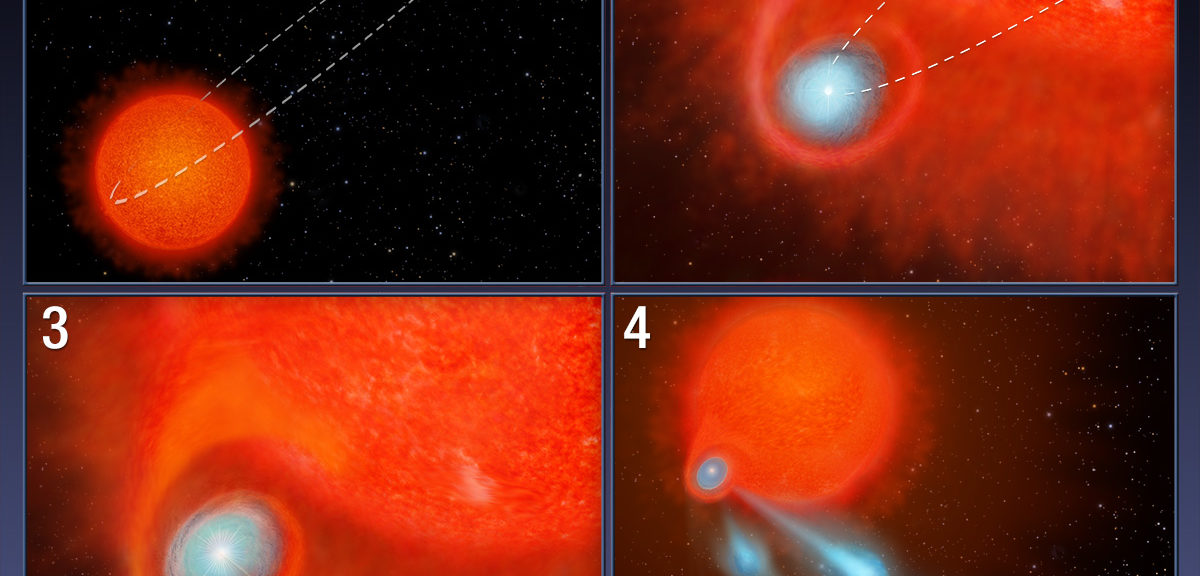
This four-panel graphic illustrates how the binary-star system V Hydrae is launching balls of plasma into space. (NASA, ESA, and A. Feild (STScI))
Astronomers Find a Cosmic Cannon
Astronomers have spotted super-hot blobs of plasma blasting into space like cannonballs near a dying red giant star, some 1,200 light years away.
Using the Hubble Space Telescope to make their discovery, the scientists found that the balls of hot gas are flying so fast a trip from the Earth to the moon would take only 30 minutes.
It’s estimated that a cosmic artillery blast has taken place every 8 and a half years for at least the past 400 years.
Hubble data revealed a sequence of these giant gas balls that date back to 1986.
The plasma balls’ temperature is thought to be more than 9,500 degrees Celsius, which is about twice as hot as the surface of the sun at 5,500 degrees Celsius.
Scientists don’t think the plasma balls are being ejected by the red giant, but by a nearby and unseen companion star that is consuming material from the atmosphere of dying star.

Composite image of the Earth at night assembled from data
acquired by the Suomi National Polar-orbiting Partnership
(Suomi NPP) satellite. (NASA Earth Observatory/NOAA NGDC)
Satellite Imagery Guides Immunization Campaigns
A Pennsylvania State University-led team of researchers has developed a system that could help public health officials conduct more thorough and complete immunization campaigns in the developing world.
Studies have shown that successful vaccination drives can improve the prevention and control of disease of outbreaks.
The new technique uses satellite imagery to help track and predict short-term shifts in population size.
The researchers studied a measles outbreak in Niger between 2003 and 2004.
The only estimates of population health officials had at the time of the outbreak did not consider seasonal migrations, which led to an underestimation of the numbers of people that needed to be immunized.
Using satellite images of nighttime light, the team was able to more accurately estimate the size of the population at the time of the outbreak.

This four-panel graphic illustrates how the binary-star system V Hydrae is launching balls of plasma into space. (NASA, ESA, and A. Feild (STScI))
Forecasting Global Dust Storms on Mars
Scientists say that dust storms on Mars aren’t as powerful as the one that set up the plot to the hit movie and book, the Martian.
But these storms still could present some serious challenges for astronauts who’ll someday land on and explore the Red Planet.
Local Martian dust storms are somewhat common and can occasionally grow into regional storms.
There have also been rare occasions when the storms can grow into a global event.
Researchers at NASA’s Jet Propulsion Laboratory are predicting a global Martian dust storm in the next few weeks or months.
The researchers noticed that current conditions are very similar to those when global storms occurred in the past.
If this prediction is proven correct, it might be possible to develop a system that can forecast future storms on the red planet.

Group of teens hanging out at the beach (Vladimir Pustovit via Flickr/Creative Commons)
Teen’s Drive for Reward Helps Them Learn
Some adults may think that teenagers today demand too much reward for little or no effort on their part.
But, a new study suggests that the need for reward may be a way evolution helps young people learn from their surrounding environment.
Study researchers had a group of teens play a picture-based learning game against a team of adults.
Some of the players were scanned with an MRI as they played.
If a player gave a right answer during the game they were rewarded with a flashing correct sign. A wrong answer resulted in a scolding incorrect sign.
The teens out performed adults in the picture game.
The MRI scans showed activity in two areas of the teen’s brain as they played, while adults, mostly used only one.
A study author says that their work proposes that teens pay attention to their environment in a way that is different than adults.

Dione with Saturn and its rings in the background. This image was taken by the Cassini spacecraft on 08/17/15 (NASA/JPL-Caltech/Space Science Institute)
Subsurface Ocean Found on Saturn Moon Dione
Belgian scientists say data from NASA’s Cassini mission has provided evidence of an ocean deep beneath the surface of Saturn’s moon Dione.
Previous studies suggested that the ringed-planet’s moon had no ocean.
With this finding, Dione joins its siblings Titan and Enceladus, as well as Jupiter’s moon Europa and possibly Pluto, in the group of celestial bodies having a subsurface ocean.
The study authors say that gravity data gathered during recent flybys by Cassini suggests Dione’s icy crust floats on an ocean several tens of kilometers deep, some 100 kilometers below its surface.
The study also proposes that Dione’s ocean surrounds a large rocky core.
The study suggests that interactions between the ocean and the moon’s rocky core could have long provided the essential ingredients needed to host microbial life.






















Comments are closed.